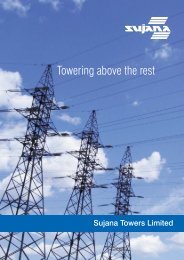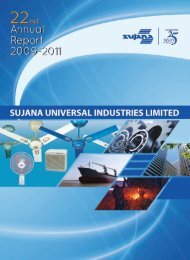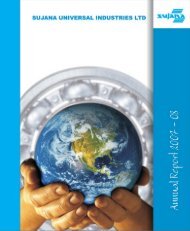Create successful ePaper yourself
Turn your PDF publications into a flip-book with our unique Google optimized e-Paper software.
SCHEDULE 22: SIGNIFICANT ACCOUNTING POLICIES<br />
1. Basis of Preparation of Financial Statements<br />
The consolidated financial statements have been prepared on accrual basis under the historical cost<br />
convention in accordance with the Accounting Standards as notified by the Companies (Accounting<br />
Standards) Rules, 2006 and the relevant provisions of the Companies Act, 1956. The financial<br />
statements are presented in Indian rupees.<br />
2. Use of Estimates<br />
The preparation of financial statements are in conformity with Indian GAAP requires management<br />
to make estimates and assumptions that affect the reported amounts of assets and liabilities and<br />
disclosure of contingent liabilities on the date of the financial statements and the reported amounts of<br />
revenues and expenses during the reporting period.Actual results could differ from those estimates.<br />
Any revision to accounting estimates is recognised prospectively in current and future periods.<br />
Examples of such estimates include provisions for doubtful debts, employee retirement benefit plans,<br />
provision for income taxes and the useful lives of fixed assets.<br />
3. Fixed Assets and Deprecation<br />
Fixed assets are stated at cost of acquisition or construction less accumulated depreciation. The cost<br />
of fixed assets comprises the purchase price (net of rebates and discounts) and any other directly<br />
attributable costs of bringing the assets to working condition for their intended use. Costs of construction<br />
are consists of those costs that relate directly to specific assets and those that are attributable to the<br />
construction activity in general and can be allocated to the specific assets up to the date when the<br />
asset is ready to use.<br />
Depreciation on fixed assets is provided using the straight-line method as per the rates prescribed<br />
in Schedule XIV to the Companies Act, 1956.The rates of depreciation prescribed in Schedule XIV<br />
to the Companies Act, 1956 are considered as minimum rates. If the management’s estimate of the<br />
useful life of a Fixed Asset at the time of acquisition of the Asset or of the remaining useful life on a<br />
subsequent review is shorter than envisaged in the aforesaid schedule, depreciation is provided at a<br />
higher rate based on the management’s estimate of the useful life / remaining useful life.<br />
Depreciation is calculated on a pro-rata basis from/upto the date the assets are purchased /sold.<br />
Individual assets costing less than Rs. 5,000 are depreciated in full in the year of purchase.<br />
4. Investments<br />
Investments are classified as current or long-term in accordance with Accounting Standard 13 on<br />
“Accounting for Investments”.<br />
Current Investments are stated at lower of cost or market value.Any reduction in the carrying amount<br />
and any reversals of such reductions are charged or credited to the Profit and Loss Account.<br />
Long term Investments are stated at cost comprising of acquisition and incidental expenses. Provision<br />
is made to recognize a diminution, other than temporary, in the value of such investments.<br />
5. Revenue Recognition<br />
Revenue is recognized when it is earned and to the extent that it is probable that the economic benefits<br />
will flow to the company and the revenue can be reliably measured.<br />
Revenue from sale of manufactured goods is recognized on physical delivery of the products, when<br />
all significant contractual obligations have been satisfied, the property in the goods is transferred for<br />
: : 103 : :









